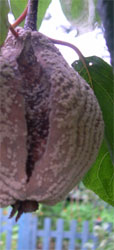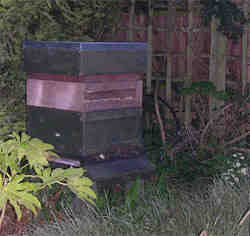Quince Jelly recipe (also works with Japonica quinces)
Posted by Fiona Nevile in Jam Jelly and Preserves | 163 comments Our friend Bunty gave us a Portuguese quince tree three years ago. Besides being very decorative, with dark branches and lazy, floppy leaves it produces the large firm fruit that make the tastiest jelly. Mature quince jelly (over six months old) turns a gorgeous amber colour.
Our friend Bunty gave us a Portuguese quince tree three years ago. Besides being very decorative, with dark branches and lazy, floppy leaves it produces the large firm fruit that make the tastiest jelly. Mature quince jelly (over six months old) turns a gorgeous amber colour.
The first year our tree produced one small quince. It bore three last year and this year suddenly came into its own. The crop would be at least ten. The fruit are quite big so there would be enough to make more than jelly. Anne Mary and I poured over her old recipe books. We could make quince marmalade or try our hand at Membrillo. Greedily I watched the quinces mature and fatten. Imagine my horror when I noticed that the fruit was splitting and rotting on the tree. The cause, I discovered, was lack of water.
It’s easy to forget trees in a drought. Especially when they have done well in their first couple of years. Old established trees have much deeper roots and can find water more easily than younger, smaller trees. It would have been so easy to take a spur from the drip watering system in the kitchen garden to the quince tree. I just didn’t think.
Our poor pear harvest was probably due to lack of water. I am going to give both trees a dressing of rich compost from our composter and cosset them this winter. Hopefully the bees will boost the germination of the blossom next spring. Our bees arrived just as the blossom was going over this year.
I managed to harvest two half quinces and they are simmering on the stove as I write this. The aroma from the simmering quinces is richly fruity. We’ll be lucky to make a couple of small jars. One for Anne Mary and one for us, as an inspiration for next year.
Quince Jelly recipe (this works well with Japonica quinces too)
Ingredients:
- 2 lbs of quinces
- 1 lemon (just the juice, sieved)
- white granulated sugar
- water to cover
Method:
- Wash and roughly chop the quinces (no need to peel, decore or depip) and place in a heavy bottomed saucepan.
- Barely cover with water. Bring to the boil and simmer gently with a lid on until soft. If the quinces are very firm this could take several hours. Check it every now and then and add more water if necessary.
- Pour the cooked fruit through sterilised muslin into a large clean bucket or bowl (how do I sterilise muslin/the jelly bag? See tips and tricks below). The muslin is often referred to as a “jelly bag”. We use tall buckets to catch the drips from the jelly bags. Rather than hang the bags (conventional method-between the legs of an upturned stool) I find it easier to line a large plastic sieve with the muslin. This clips neatly onto the top of a clean bucket. The sieve is covered with a clean tea cloth to protect against flies.
- Leave the jelly bag to drip overnight (or about 12 hours).
- Measure the juice the next day.
- Pour the juice into a deep heavy bottomed saucepan and add 1lb/454g of white granulated sugar for each 1pt/570ml of juice.
- Add the lemon juice.
- Heat the juice and sugar gently stirring from time to time, so as to make sure that that all the sugar has dissolved before bringing the liquid slowly to the boil.
- Continue to boil for about 10 minutes before testing for a set. This is called a rolling boil. Test every 3 to 5 minutes until setting point is reached. (What is testing for a set? See tips and tricks below). Tossing in a nugget of butter towards the end will reduce the frothing that can occur.
- When jelly has reached setting point pour into warm sterilised jars using a funnel and ladle. (How do I sterilise jars? See tips and tricks below).
- Cover immediately with plastic lined screw top lids or waxed disks and cellophane tops secured with a rubber band. If you don’t think that the jelly has set properly, you can reboil it the next day. The boiling reduces the water in the jelly. I have done this in the past. Ideally you should try for the right set the first time.
- Label when cold and store in a cool, dark place. Away from damp.
Tips and tricks:
- What is a jelly bag?
A jelly bag is traditionally a piece of muslin but it can be cheesecloth, an old thin tea cloth or even a pillowcase. The piece needs to be about 18″ square. When your fruit is cooked and ready to be put in the jelly bag, lay your cloth over a large bowl. Pour the fruit into the centre of the cloth and tie the four corners together so that they can be slung on a stick to drip over the bowl. Traditionally a stool is turned upside down, the stick is rested on the wood between the legs and the jelly bag hangs over the bowl. We experimented and now line a sieve with muslin, place it over a bucket and cover the lot with clean tea cloths (against the flies). - How do I sterilise muslin/the jelly bag?
Iron the clean jelly bag with a hot iron. This method will also sterilise tea cloths. - Jelly “set” or “setting point”?
Getting the right set can be tricky. I have tried using a jam thermometer but find it easier to use the following method.
Before you start to make the jelly, put a couple of plates in the fridge so that the warm jam can be drizzled onto a cold plate (when we make jam we often forget to return the plate to the fridge between tests, using two plates means that you have a spare cold plate). When testing for a set drizzle some jelly into the cold plateand return the plate to the fridge to cool for approx two minutes. It has set when you run your finger through it and leave a crinkly track mark. If after two minutes the cooled jam is too liquid, continue to boil the jelly, testing it every few minutes until you have the right set. The jelly is far more delicious if it is slightly runny. It does get firmer after a few months. - How do I sterilise the jars and lids?
We collect jars all year round for our jelly, chutney and jam making sessions. I try to soak off labels and store the clean jars and metal plastic coated screw-top lids in an accessible place. The sterilising method that we use is simple. Just before making the jam, I quickly wash and rinse the jars and place them upside down in a cold oven. Set the temperature to 160c/140c for fan assisted. When the oven has reached the right temperature I turn off the heat. The jars will stay warm for quite a while. I only use plastic lined lids for preserves as the all-metal lids can go rusty. I boil these for five minutes in water to sterilise them. If I use Le Parfait jars, I do the same with the rubber rings.
Leave a reply






Best yield ever this year.
Never thought about a lemon, will give it a go but not sure of the butter! As I do a couple of lbs at a time. THANKS
Kim
This is the BEST quince recipe I have found ?
I pushed the pulp through a sieve as I needed to transport it and couldn’t leave it overnight. It looks like cooked squash now and I’m worried I’ve ruined it. Any suggestions please.
No problem, will still become delicious jam,
This is such a simple recipe and it’s my third year of using it. I am about to cook my quince today, in readiness for turning into jelly and bottling tomorrow.
Great recipe ! Easy, peasey,japanesey ! Well just waking to see if it will set but tastes wonderful
Thanks for all your tips and advice which has been really helpful over the years. I must admit though that I am confused – horticulture is a mystery I seem not to be able to fathom – by James (October 20, 2014) who truly seemed to know what he was saying, stating that ‘the true quince is Cydonia oblonga and the Japanese quince is Chaenomeles japonica’. The Royal Horticultural Society lists Cydonia Japonica in its recipes. Can anyone explain as I am truly bewildered by these conflicting statements.
Hello christine, did anyone answer your question? If not.. Japanese quince and true quince are two totally different pnants – it is the curse of common names that is confusing ou! ‘True’ quince is cydonia oblonga, which is a big fruit about the size of a large pear, which grows on a medium sized tree. It has lovely big white flowers in spring Japanese quince isw chaenomoles japonica, which is a fruit about the size of a lemon, growing on a spiny bush which has white, pink or red flowers. Both make really good jelly – my favourite is the japanes quince, in particular an old vriety called ‘Crimson ‘n gold’ which has dark red flowers and fruit which are incredibly hard. _ I attack mine with a huge knife to chop them up. I hope that is helpful.. J
Thank you for the bucket and sieve tip. After years of using jelly bag and upturned stool this is so neat, cleaner, looks better and works like a dream!
I have used this recipe a few times now with good results. The only thing that I would add is that if you’re using Japanese quinces (Chaenomeles japonica), which are much sharper tasting than true quinces (Cydonia oblonga), it helps to use about 50% more sugar. That’s 1.5 lbs of sugar per Imperial pint (568 ml). If you wish to be cautious, then you could add just 1 lb of sugar per pint to begin with, and then taste it once the sugar has dissolved to see if it needs more sugar.
I just wanted to thank you for yet another wonderful recipe that has worked out really well. I have been using your recipes for the last few years and my jelly and jams have been really good and not one of them went wrong!
So a big THANK YOU from my family, friends and me!
I love this quince jelly recipe and have used it for a number of years with delicious results. Wonderful to discover that there is no need to remove the pips and fiddle about coring which saves oodles of time. Thanks for the post.